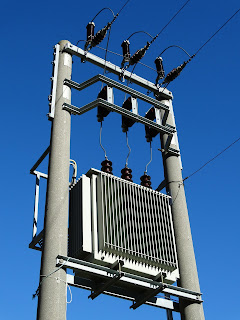The principle of the transformer is
the mutual induction between two coils. When an electric current passes
through a coil and changes with time, an EMF is induced in the neighbouring coil.
A transformer is a device which is used to transform electrical
power from one circuit to another without changing its frequency. The applied
alternating voltage is either increased or decreased with a corresponding
decrease or increase of current in the circuit. If the transformer converts an
alternative current with low voltage into an alternating current with high
voltage, it is called a step-up transformer. On the contrary, if the transformer
converts alternating current with high voltage, it is called a step-up
transformer. If the transformer converts an alternating current with high voltage
into an alternating current with low voltage, then it is called a step-down
transformer.
In the
simple construction of transformers, there are two coils of high mutual
inductance wound over the same transformer core. The core is made up of silicon
steel. Both coils are electrically insulated but magnetically linked via the transformer core. If the primary coil is connected to a source of alternating
voltage, an alternating magnetic flux is set up in the laminated core. If there
is no magnetic flux linked with the primary coil is also linked with the secondary
coil. This means that the rate at which magnetic flux changes through each turn is the same for both primary and secondary coils. As a result of flux change, emf is
induced in both primary and secondary coils.
Efficiency of transformer
The efficiency of a transformer is defined as the ratio of the
useful output power to the input power. Almost 96-99% of efficiency we expect
from a transformer device, the transformer is one of the highly efficiency devices.
Input power
Energy losses in a transformer:
When an electric current flows through them, some amount of
energy is dissipated due to joule heating. This energy loss is called a copper
loss. Energy loss due to the flux leakage is minimized by winding coils one
over the other. Hysteresis loss and eddy current loss are called core loss.
Tags
physics

